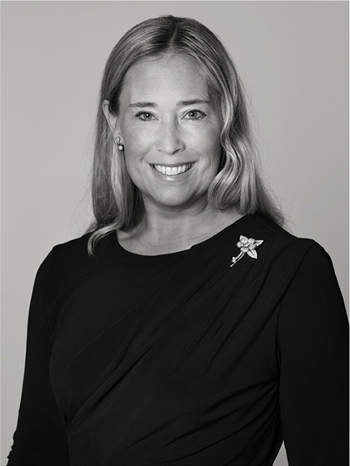A flower shaped jade placque, Qing dynasty, 18th century.
Elegantly carved, sculptured as a flower, holes for fastening on a dress or in a piece of jewellery. The other side with swirls and yin/yang at the center. Diameter 8 cm.
Natural inclusions and feathering to the stone.
Provenance
The Carl Kempe Collection.
Bukowskis is privileged to offer a selection of Chinese gold, silver, and gilt-bronze works of art, dating from the Six Dynasties to the Ming Dynasty, from the collection of the eminent collector, Carl Kempe (1884-1967) and offered by his family.
The Swedish industrialist Carl Kempe was a leading figure of the Swedish pulp and paper industry, as well as an accomplished tennis player who won a silver medal at the 1912 Summer Olympics in Stockholm. Today he is better known internationally as a famed collector of Chinese antiquities.
Carl Kempe’s interest in Chinese art began in the early 1920s. He belonged to a group of Chinese art connoisseurs who began collecting in the early 20th century; he was also a member of the China Committee, created by HRH Gustav Adolf, later HRH King Gustav VI Adolf of Sweden, Torsten Laurin, Johan Gunnar Andersson, Axel Carlander and Axel Lagrelius amongst others to acquire art from China. The China Committee later transformed into the China Club in Stockholm (a local branch of the Oriental Ceramic Society in London).
Delving into Carl Kempe’s inventories from the 1920’s and onwards one can see that he acquired items from Paris dealers such as C. T. Loo, Monsieur N. Knudsen and Monsieur L. Michon, and from London dealer Bluett & Sons, Sydney L. Moss, Yamanaka & Co., John Sparks, Mr Peter Boode, Mr Norton, K. Shimuzu, Spink & Son, Beijing dealers Wang Chia Yu and Cang I Chen, from Shanghai E. T. Chow, and from Stockholm dealers Hans Öström, C. E. Gadelius, Orvar Karlbeck, and the Karlbeck Consortium.
Following his initial interest in Chinese art in the 1920s, Carl Kempe and his wife travelled to China in 1935-1936, were he met up with the other famed Swedes out there such as Johan Gunnar Andersson, whose expeditions, and excavations he sponsored. In China it has been reported that he purchased some 250 items of Chinese art.
Kempe had been attracted to Qing dynasty polychrome porcelains initially, but he later developed a particular interest in white-glazed ceramics – especially those from the Tang-Song period.
The other area in which he developed a great interest in and subsequently formed a spectacular collection, was Chinese gold and silver, which ranged from the Bronze Age Zhou dynasty to the Qing dynasty.
His third area of specialised collecting was Chinese glass, that he bequeathed to the Östasitiska Museet in Stockholm, although he also acquired fine examples of Chinese lacquer, enamels, bronzes, and other items, as well expanding his interests to Roman, Egyptian, Islamic and Etruscan glass, and gold.
He also loaned pieces from the collection to several international exhibitions, for example, to the ‘Ausstellung der Vereinigung der Freunde Ostasiatischer Kunst, Köln, 1926,
the famous 1935-36 International Exhibition of Chinese Art in London (see listing on page xxxi index of lenders). His good friend J. G. Andersson gave a lecture at the Royal Society, Burlington House, December 5th, 5 P.M. "The Goldsmith in Ancient China". The Arts de la Chine Ancienne, Musee de L’Orangerie, Paris, 1937. After this exhibition he seems to have purchased some gold items that was on loan by Madame de Wannieck, Paris. He also lends a good number of items to the exhibition in Copenhagen ‘Kinas Kunst i Svensk og Dansk eje, det danske Kunstindustrimuseum, Kobenhamn’, 1950.
As an enthusiastic, academic collector (he described himself as a manic collector), Kempe welcomed scholars and collectors from all over the world, to view, discuss and research his remarkable collection and collected to end of his days. Kempe sponsored numerous research projects and excavations and was a true patron of the arts and made numerous donations to Östasiatiska Museet in Stockholm.
After his death in 1967 the collection continued to be displayed at his residence at Ekolsund Castle, and in the 1970s his daughters followed their father’s footsteps and agreed to lend some 150 items of ceramics, gold, and silver from the Kempe collection. So, they were sent on a touring exhibition in the United States in collaboration with The Asia Society and the Smithsonian, published by Bo Gyllensvärd, who wrote his PhD on the Collection, in Chinese Gold and Silver and Porcelain - The Kempe Collection, 1971.
In 1997 a large part of the Kempe collection of ceramics, gold and silver was sold to the Museum of Art and Far Eastern Antiquities in Ulricehamn. Some ten years later the collection was sold at auction and part of them were auctioned at a sale entitled Masterpieces of Chinese Precious Metalwork: Early Gold and Silver, held by Sotheby’s London on 14 May 2008.
The objects now on offer have remained with Kempe family – and are now offered for sale by the family.
Exhibitions
Compare jade flowers at the British Museum, Museum number 2022,3034.218.
Literature
Rawson 1995 / Chinese Jade from the Neolithic to the Qing (cat.no.25.16) Similar flowers have been discussed by Cheng Te-k'un in his study of jade flowers. On the basis of an unpublished comparison with a jade said to come from a Jin dynasty tomb in south-west Shaanxi, these substantial examples are generally given a fairly early date. The evidence has been accepted by James Watt. See Rawson 1995, p.339, cat.no.25.16.
































